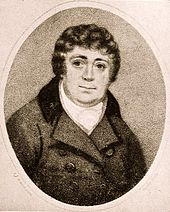
Islington is a district in the north of Greater London, England, and part of the London Borough of Islington. It is a mainly residential district of Inner London, extending from Islington's High Street to Highbury Fields, encompassing the area around the busy High Street, Upper Street, Essex Road, and Southgate Road to the east.

Richard Turpin was an English highwayman whose exploits were romanticised following his execution in York for horse theft. Turpin may have followed his father's trade as a butcher early in his life but, by the early 1730s, he had joined a gang of deer thieves and, later, became a poacher, burglar, horse thief, and killer. He is also known for a fictional 200-mile (320 km) overnight ride from London to York on his horse Black Bess, a story that was made famous by the Victorian novelist William Harrison Ainsworth almost 100 years after Turpin's death.

Claude Du Vall (or Duval) (c. 1643 – 21 January 1670) was a French highwayman in Restoration England. He worked in the service of exiled royalists who returned to England under King Charles II. Little else is known of his history. According to popular legend, he abhorred violence, showing courtesy to his victims and chivalry to their womenfolk, thus spawning the myth of the romantic highwayman, as taken up by many novelists and playwrights.
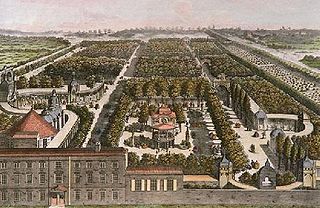
Vauxhall Gardens is a public park in Kennington in the London Borough of Lambeth, England, on the south bank of the River Thames.

Beacon Park is a public park in the centre of the city of Lichfield, Staffordshire, in England. The park was created in 1859 when the Museum Gardens were laid out adjacent to the newly built Free Museum and Library. The park has since been extended in stages and now forms 69 acres (28 ha) of open parkland in the city centre. The park is in the northwest of the city centre and to the west of the Cathedral Close across the road from the Garden of Remembrance.

A pleasure garden is a park or garden that is open to the public for recreation and entertainment. Pleasure gardens differ from other public gardens by serving as venues for entertainment, variously featuring such attractions as concert halls, bandstands, amusement rides, zoos, and menageries.
Lisson Grove is a street and district in the City of Westminster, West London. The West End neighbourhood contains a few important cultural landmarks, including Lisson Gallery, Alfies Antique Market, Red Bus Recording Studios, the former Christ Church, now the Greenhouse Centre, Stringers of London and the Seashell of Lisson Grove.

John Donowell was an eighteenth-century British architect and engraver, considered to be the equivalent of Thomas Sandby and Thomas Malton as one of the principal architect-draughtsmen in the third quarter of the eighteenth century. He exhibited in 1761 at the Free Society, then through the 1760s at the Society of Artists, and from 1778 to 1786 at the Royal Academy; prints, some hand-coloured, were published at this time.
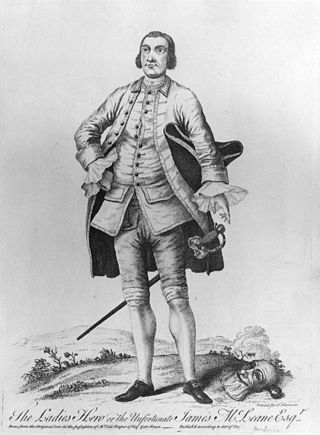
"Captain" James Maclaine was an Irish man of a respectable presbyterian family who had a brief but notorious career as a mounted highwayman in London with his accomplice William Plunkett. He was known as "The Gentleman Highwayman" as a result of his courteous behaviour during his robberies, and obtained a certain kind of celebrity. Notoriously, he held up and robbed Horace Walpole at gunpoint: eventually he was hanged at Tyburn.
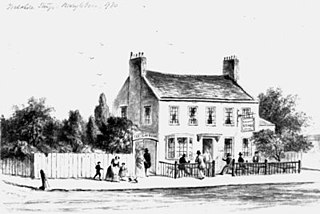
The Yorkshire Stingo was a public house in Marylebone, London in the 18th to mid-20th century. Its name derived from the custom for Yorkshiremen in London to gather at the pub and its adjoining pleasure gardens on the first three days of May each year. In May 1808 it was reported that over 20,000 people gathered there, drinking strong ale, and playing football and other 'rustic Yorkshire sports'. The Stingo part of its name comes from a fashionable 18th century slang word for strong or old ale. The term is possibly derived from the sharp, or "stinging" flavour of a well-matured beer.
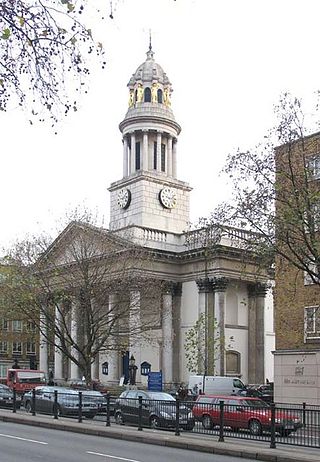
St Marylebone Parish Church is an Anglican church on the Marylebone Road in London. It was built to the designs of Thomas Hardwick in 1813–17. The present site is the third used by the parish for its church. The first was further south, near Oxford Street. The church there was demolished in 1400 and a new one erected further north. This was completely rebuilt in 1740–42, and converted into a chapel-of-ease when Hardwick's church was constructed. The Marylebone area takes its name from the church. Located behind the church is St Marylebone School, a Church of England school for girls.

Marylebone High Street is a shopping street in London, running sub-parallel to Baker Street and terminating at its northern end at the junction with Marylebone Road. Given its secluded location, the street has been described as "the hidden wonder of the West End" and it was voted Best Street in London in 2002 by listeners of BBC Radio 4, winning praise for its being "a haven in the middle of the frantic city." Marylebone High Street was also an electoral ward of the City of Westminster from 2002 to 2022; its population at the 2011 Census was 10,366.

The Vauxhall Gardens, was a pleasure garden and theater. It was named for the Vauxhall Gardens of London. Though the venue passed through a long list of owners, and suffered buyouts, closings, relocations, and re-openings, it lasted until the mid-19th century.

The Bunch-of-Grapes was a tavern located on King Street in Boston in the Province of Massachusetts Bay in the 17th and 18th centuries. It served multiple functions in the life of the town, as one could buy drinks and meet friends, business associates, political co-conspirators. The facade of the Bunch-of-Grapes building featured an iconic sign: "Three gilded clusters of grapes dangled temptingly over the door before the eye of the passer-by."

Marylebone is an area in London, England and is located in the City of Westminster. It is in Central London and part of the West End. Oxford Street forms its southern boundary.
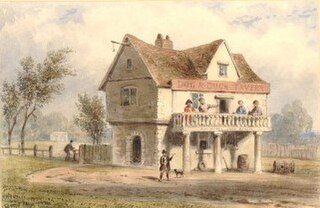
The Dog and Duck was a tavern built upon St George's Fields in London in the 17th century. It was named after the sport of duck-baiting, that took place in adjacent wetland. In the 18th century its gardens were used as a spa but, by the 1770s, with spas no longer fashionable, it declined into a rowdy location for concerts. The magistrates refused to renew its licence, despite protracted legal disputes, and it closed in 1799. The building was then used as a School for the Indigent Blind and demolished in 1812, when the new Bethlem Hospital was built upon the site. That building is now used by the Imperial War Museum.

Weymouth Street lies in the Marylebone district of the City of Westminster and connects Marylebone High Street with Great Portland Street. The area was developed in the late 18th century by Henrietta Cavendish Holles and her husband Edward Harley, 2nd Earl of Oxford. This part of Marylebone was noted to part of Manor of Tyburn and dates back to the year 1086.

Tamworth Greyhound Stadium was a greyhound racing and speedway stadium in Fazeley near Tamworth, Staffordshire.

Hillfield Gardens is a public park on London Road, Gloucester, England. It houses several historical monuments. The description in December 2020 stated: "Now a Council-owned public park covering about 1.6 hectares, Highfield Gardens is supported by an active Friends group which organises annual events".
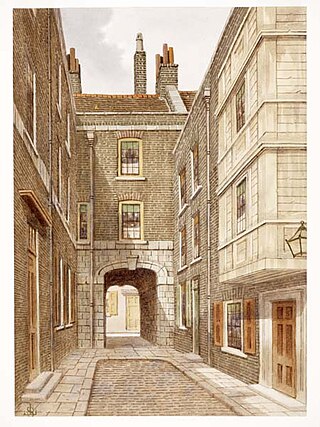
Hanging Sword Alley is an alley in the Alsatia district of London, running between Whitefriars Street and Salisbury Square, close to Fleet Street.

